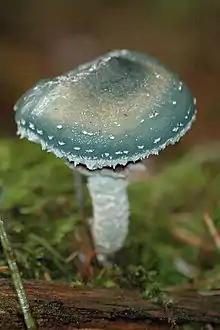球蓋菇屬
球蓋菇屬(學名:Stropharia、英語:)是一群中至大型的傘菌,其特徵為蕈柄上有一圈膜質的蕈環。本屬中較有名的物種包括大球蓋菇與銅綠色的銅綠球蓋菇。球蓋菇屬的物種通常不被認為是可食的,且許多種類的可食性受到質疑,但大球蓋菇在剛長成時是可食的,且野外露營者主要食用的菇種之一[2]。
| 球盖菇属 | |
|---|---|
 | |
| 銅綠球蓋菇 | |
| 科学分类 | |
| 界: | 真菌界 Fungi |
| 门: | 担子菌门 Basidiomycota |
| 纲: | 傘菌綱 Agaricomycetes |
| 目: | 伞菌目 Agaricales |
| 科: | 球蓋菇科 Strophariaceae |
| 属: | 球盖菇属 Stropharia (Fr.) Quél. (1872) |
| 模式种 | |
| 銅綠球蓋菇 (Curtis) Quél. (1872) | |
| 異名[1] | |
|
Geophila Quél. (1886) | |
| 维基物种中的分类信息:球蓋菇屬 |
分類
球蓋菇屬的學名Stropharia衍生自希臘文的στροφος(音strophos),意為「帶狀物」。屬內物種的變異很大,且被認為是個複系群,其中核心支序的共同特徵為形成假根的菌絲體中含有許多棘紅細胞,在Stropharia acanthocystis中,棘紅細胞亦存在於子實層。分子證據分析證明球蓋菇屬核心支序的關係與黏滑菇属與鳞伞属較近,而與屬內其他物種(如S. semiglobata)相差較遠。2013年,Scott Redhead將球蓋菇屬中不含棘紅細胞,且囊狀體呈星狀(astrocystidia)者獨立為Protostropharia屬,而Protostropharia semiglobata即為模式種[3]。
德國真菌學家洛夫·辛格將球蓋菇屬的物種進一步區分為數個組,有些缺乏棘紅細胞的節已被提升為獨立的屬[4][5][6][7],如2008年提升的Leratiomyces屬是來自球蓋菇屬的Stropholoma節,前述的Protostropharia屬是來自Stercophila節。
屬於迷幻蘑菇的古巴裸盖菇曾被分類在球蓋菇屬,之後被辛格改分至裸蓋菇屬,此變動與後續DNA序列分析一致[4][6][7]。古巴裸蓋菇的中大型大小、發育完整的蕈環與深色的孢子和球蓋菇外表相像,但應屬於裸蓋菇屬,而和球蓋菇屬沒有密切關係[8]。
物種
- Stropharia acanthocystis
- 銅綠球蓋菇 Stropharia aeruginosa
- Stropharia agaricoides[9]
- Stropharia albivelata
- Stropharia albonitens
- Stropharia alcis
- Stropharia aurantiaca
- Stropharia caerulea
- Stropharia coronilla
- Stropharia halophila
- Stropharia hornemannii
- Stropharia inuncta
- Stropharia kauffmanii
- Stropharia lepiotiformis
- Stropharia luteonitens
- Stropharia mammillata
- Stropharia melanosperma
- Stropharia pseudocyanea
- 大球蓋菇 Stropharia rugosoannulata
- Stropharia semiglobata
- Stropharia squamulosa
- Stropharia venusta[9]
參考資料
- . MycoBank.International Mycological Association. [2011-09-11].
- Paul Stamets, Growing gourmet and medicinal mushrooms, pg. 334, Ten Speed Press, 3rd ed. (2000), ISBN 1-58008-175-4
- Redhead SA. (PDF). Index Fungorum. 2013, 15: 1–2.
- Moncalvo JM, Vilgalys R, Redhead SA, Johnson JE, James TY, Catherine Aime M, Hofstetter V, Verduin SJ, Larsson E, Baroni TJ, Greg Thorn R, Jacobsson S, Clémençon H, Miller OK. (PDF). Molecular Phylogenetics and Evolution. 2002, 23 (3): 357–400. PMID 12099793. doi:10.1016/S1055-7903(02)00027-1.
- Redhead SA. (PDF). Index Fungorum. 2013, 15: 1–2.
- Walther G, Garnica S, Weiß M. . Mycological research. 2005, 109 (5): 525–44. PMID 16018308. doi:10.1017/S0953756205002868.
- Matheny PB, Curtis JM, Hofstetter V, Aime MC, Moncalvo JM, Ge ZW, Slot JC, Ammirati JF, Baroni TJ, Bougher NL, Hughes KW, Lodge DJ, Kerrigan RW, Seidl MT, Aanen DK, DeNitis M, Daniele GM, Desjardin DE, Kropp BR, Norvell LL, Parker A, Vellinga EC, Vilgalys R, Hibbett DS. (PDF). Mycologia. 2006, 98 (6): 982–95. PMID 17486974. doi:10.3852/mycologia.98.6.982. (原始内容 (PDF)存档于2016-03-03).
- O. T. Oss, O. N. Oeric, Psilocybin: magic mushroom grower's guide: a handbook for psilocybin Enthusiasts, Quick American Archives, 2nded. (1993), ISBN 0-932551-06-8
- da Silva PS, Cortez VG, da Silveira RMB. . Mycologia. 2009, 101 (4): 539–44. doi:10.3852/08-097.
This article is issued from Wikipedia. The text is licensed under Creative Commons - Attribution - Sharealike. Additional terms may apply for the media files.
